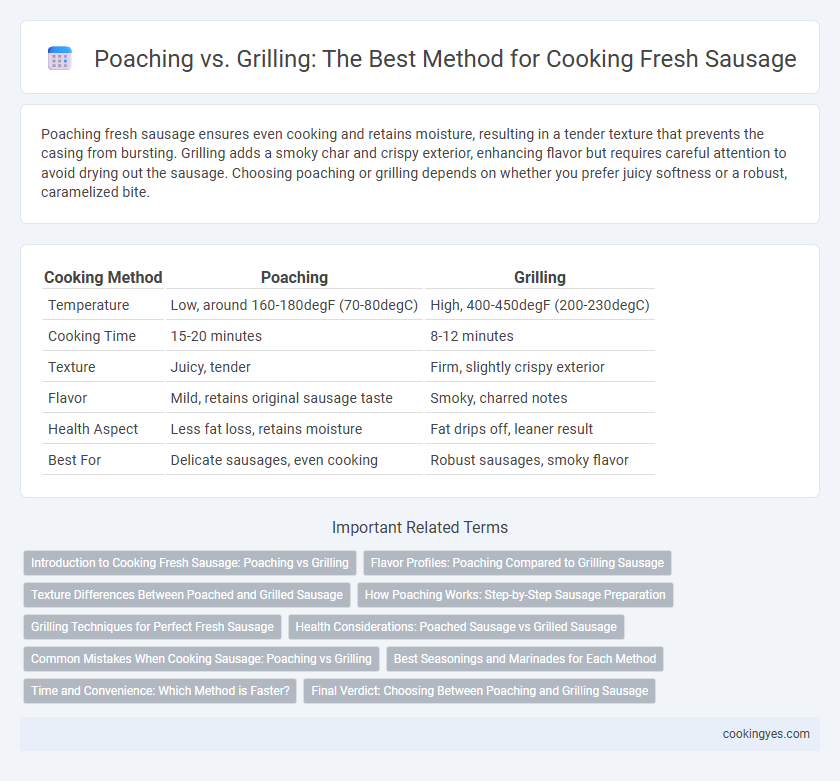Poaching fresh sausage ensures even cooking and retains moisture, resulting in a tender texture that prevents the casing from bursting. Grilling adds a smoky char and crispy exterior, enhancing flavor but requires careful attention to avoid drying out the sausage. Choosing poaching or grilling depends on whether you prefer juicy softness or a robust, caramelized bite.
Table of Comparison
| Cooking Method | Poaching | Grilling |
|---|---|---|
| Temperature | Low, around 160-180degF (70-80degC) | High, 400-450degF (200-230degC) |
| Cooking Time | 15-20 minutes | 8-12 minutes |
| Texture | Juicy, tender | Firm, slightly crispy exterior |
| Flavor | Mild, retains original sausage taste | Smoky, charred notes |
| Health Aspect | Less fat loss, retains moisture | Fat drips off, leaner result |
| Best For | Delicate sausages, even cooking | Robust sausages, smoky flavor |
Introduction to Cooking Fresh Sausage: Poaching vs Grilling
Poaching fresh sausage involves gently cooking it in simmering water, which helps retain moisture and ensures even cooking without the risk of burning. Grilling imparts a smoky flavor and creates a crispy, caramelized exterior by cooking the sausage over direct heat. Both methods require careful temperature control to maintain juiciness while achieving the desired texture and flavor.
Flavor Profiles: Poaching Compared to Grilling Sausage
Poaching sausage preserves its natural juiciness and delivers a mild, tender flavor, allowing subtle spices to shine without the intensity of charring. Grilling sausage enhances its flavor with smoky, caramelized notes and a crispy exterior, intensifying spices through the Maillard reaction. Choosing poaching or grilling directly impacts the sausage's texture and flavor complexity, with poaching highlighting freshness and grilling emphasizing robust, smoky character.
Texture Differences Between Poached and Grilled Sausage
Poaching fresh sausage results in a tender and juicy texture due to gentle cooking in water, preserving moisture and preventing the casing from becoming tough. Grilling sausage creates a firmer, slightly crispy exterior with charred marks, offering a more robust texture contrast between the casing and the interior. The choice between poaching and grilling significantly affects texture by balancing moisture retention with crispness.
How Poaching Works: Step-by-Step Sausage Preparation
Poaching fresh sausage involves gently cooking it in simmering water or broth at around 160-180degF (71-82degC), which ensures even heat distribution without causing the casing to burst. This gentle cooking process helps retain moisture and enhances flavor by allowing the sausage to cook through slowly before finishing with a quick sear or grill for a crispy exterior. Poaching prevents overcooking and reduces the risk of drying out the sausage, making it an ideal preparation step before grilling.
Grilling Techniques for Perfect Fresh Sausage
Grilling fresh sausage enhances flavor by caramelizing the casing and locking in juices, achieving a crispy exterior with a tender interior. Use medium heat and indirect grilling to prevent burning while allowing even cooking throughout the sausage. Pierce the sausage sparingly to retain moisture, turning frequently to ensure uniform browning and avoid flare-ups.
Health Considerations: Poached Sausage vs Grilled Sausage
Poaching fresh sausage reduces the formation of harmful compounds like heterocyclic amines (HCAs) and polycyclic aromatic hydrocarbons (PAHs), making it a healthier cooking method compared to grilling. Grilled sausage, exposed to direct high heat and open flames, tends to develop more char and potentially carcinogenic substances. Opting for poaching minimizes calorie intake by avoiding added fats often used in grilling and preserves the sausage's moisture and nutrients.
Common Mistakes When Cooking Sausage: Poaching vs Grilling
Poaching fresh sausage helps maintain juiciness and prevents splitting, unlike grilling which can quickly overcook and dry the meat if not carefully monitored. A common mistake when grilling sausage is applying high heat immediately, causing the casing to burst and juices to escape. Proper poaching before grilling allows even cooking and retains flavor, while skipping this step often leads to uneven texture and toughness.
Best Seasonings and Marinades for Each Method
Poaching fresh sausage preserves its natural juices and allows delicate herbs like thyme, sage, and bay leaves to infuse subtle flavors, making light marinades with white wine or apple cider vinegar ideal. Grilling sausages develops a smoky char that complements bold seasonings such as smoked paprika, garlic powder, and crushed red pepper flakes, with marinades featuring olive oil, mustard, and fresh rosemary enhancing the robust taste. Selecting the right seasoning balance based on cooking method maximizes flavor depth and texture, ensuring an optimal culinary experience.
Time and Convenience: Which Method is Faster?
Poaching fresh sausage typically takes about 10-15 minutes, offering a controlled and even cooking process that preserves moisture and reduces the risk of bursting. Grilling, while delivering a smoky flavor and crispy exterior, usually requires about 12-20 minutes depending on sausage thickness and grill heat, and involves more active attention to avoid burning. For faster, more convenient cooking, poaching provides quicker and more hands-off preparation compared to the longer, more involved grilling method.
Final Verdict: Choosing Between Poaching and Grilling Sausage
Poaching sausage ensures even cooking and retains moisture, producing a tender texture ideal for delicate or fresh sausages such as bratwurst and Italian links. Grilling adds a smoky flavor and crisp exterior, enhancing sausages with higher fat content like chorizo or kielbasa while creating appealing grill marks and caramelization. Choosing between poaching and grilling depends on desired taste and texture: poaching for juiciness and tenderness, grilling for robust flavor and charred finish.
Poaching vs grilling for cooking fresh sausage Infographic

 cookingyes.com
cookingyes.com